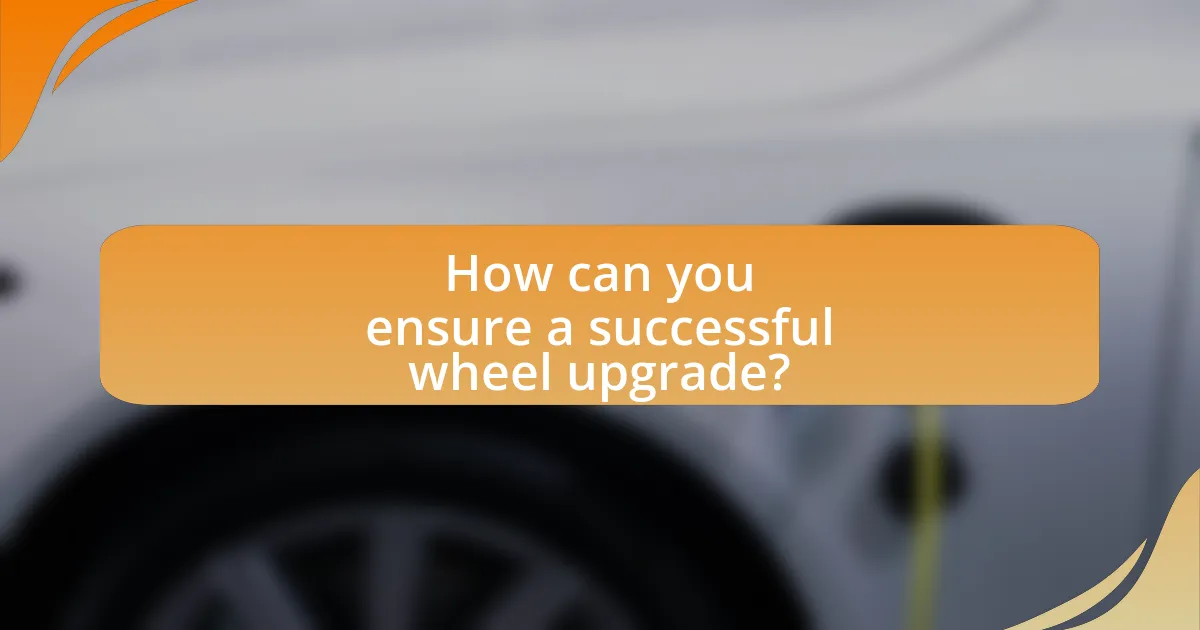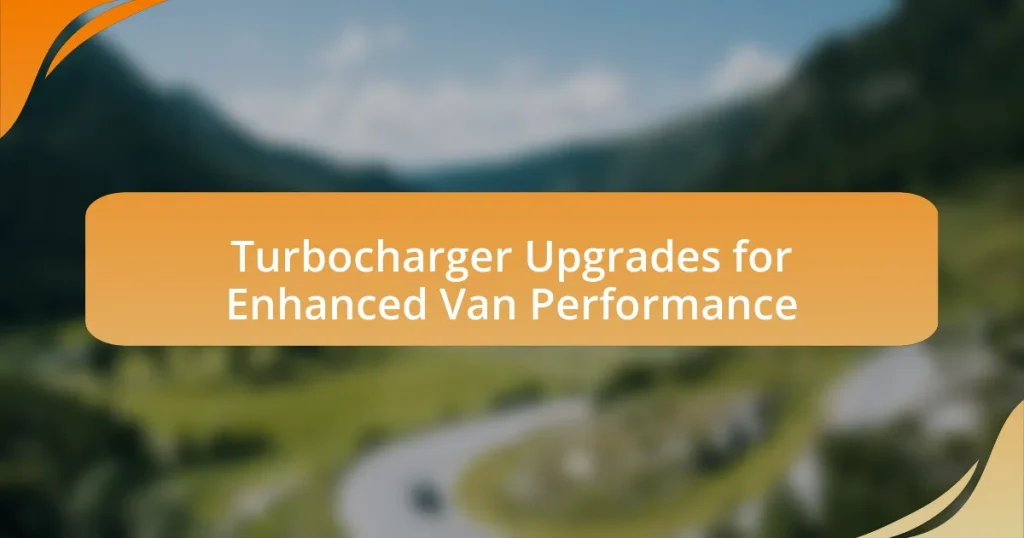The article focuses on upgrading your van’s wheels, emphasizing both aesthetic and performance considerations. Key factors to consider include wheel size, material, offset, and tire compatibility, all of which impact handling, ride quality, and vehicle stability. Upgrading wheels can enhance performance through improved traction and reduced weight, while also providing aesthetic benefits that can increase the vehicle’s appeal and resale value. The article also addresses potential drawbacks of wheel upgrades, maintenance practices, and troubleshooting tips for common wheel issues, ensuring a comprehensive understanding of the implications and best practices for wheel upgrades.
What are the key considerations for upgrading your van’s wheels?
The key considerations for upgrading your van’s wheels include size, material, offset, and tire compatibility. Selecting the right wheel size is crucial as it affects handling, ride quality, and clearance; for instance, larger wheels can enhance aesthetics but may compromise comfort. The material, such as aluminum or steel, influences weight and durability, with aluminum being lighter and often preferred for performance. Offset determines how the wheel sits in relation to the suspension and body, impacting stability and alignment. Lastly, ensuring tire compatibility is essential, as the new wheels must accommodate the tires you intend to use, which affects traction and safety.
Why is upgrading wheels important for your van?
Upgrading wheels is important for your van because it enhances both performance and aesthetics. Improved wheels can lead to better handling, increased traction, and reduced weight, which collectively contribute to improved fuel efficiency and overall driving experience. For instance, lighter alloy wheels can decrease unsprung weight, allowing for better suspension response and handling. Additionally, visually appealing wheels can significantly enhance the van’s appearance, making it more attractive and potentially increasing its resale value.
How do upgraded wheels enhance performance?
Upgraded wheels enhance performance by improving traction, reducing weight, and increasing handling responsiveness. Enhanced traction results from wider tires and better rubber compounds, which provide a larger contact patch with the road, leading to improved grip during acceleration, braking, and cornering. Additionally, lighter wheels decrease the overall unsprung weight of the vehicle, allowing for quicker acceleration and improved fuel efficiency. Furthermore, upgraded wheels often feature designs that optimize airflow to brakes, aiding in heat dissipation and maintaining braking performance. These factors collectively contribute to a more dynamic driving experience and better overall vehicle performance.
What aesthetic improvements can be achieved with new wheels?
New wheels can significantly enhance the aesthetic appeal of a vehicle by providing a modern and stylish look. Upgrading to larger or uniquely designed wheels can create a more aggressive stance, while different finishes, such as matte or chrome, can add a touch of sophistication. Additionally, custom wheel designs can reflect personal style, making the vehicle stand out. According to a study by the Specialty Equipment Market Association, 70% of vehicle owners believe that wheels are a key factor in a vehicle’s overall appearance, highlighting their importance in aesthetic upgrades.
What factors should you consider when choosing new wheels?
When choosing new wheels, consider factors such as size, material, design, and compatibility with your vehicle. The size of the wheels affects handling, ride quality, and aesthetics; larger wheels can improve performance but may compromise comfort. Material influences weight and durability, with options like aluminum being lighter and more resistant to corrosion compared to steel. The design impacts the overall look of the vehicle and can enhance or detract from its aesthetic appeal. Compatibility with your van’s specifications, including bolt pattern and offset, is crucial to ensure proper fit and performance.
How do wheel size and type affect your van’s handling?
Wheel size and type significantly influence a van’s handling by affecting stability, traction, and responsiveness. Larger wheels typically provide better cornering stability and improved grip due to a larger contact patch with the road, which enhances traction during acceleration and braking. Conversely, smaller wheels may offer a softer ride and better maneuverability in tight spaces but can compromise stability at higher speeds. Additionally, the type of wheel, such as alloy versus steel, impacts weight and heat dissipation; lighter alloy wheels can improve handling by reducing unsprung weight, leading to quicker response times and better overall performance. Studies indicate that a 1-inch increase in wheel diameter can enhance cornering grip by approximately 5%, demonstrating the tangible effects of wheel size on handling dynamics.
What materials are best for performance and aesthetics?
Aluminum and carbon fiber are the best materials for performance and aesthetics in wheel upgrades. Aluminum wheels offer a balance of lightweight properties and strength, enhancing vehicle performance through improved handling and fuel efficiency. Additionally, aluminum can be finished in various styles and colors, providing aesthetic versatility. Carbon fiber wheels, while more expensive, are even lighter and stronger than aluminum, significantly reducing unsprung weight, which enhances acceleration and braking performance. Their sleek appearance also adds a modern, high-end look to any vehicle.
What are the potential drawbacks of upgrading your van’s wheels?
Upgrading your van’s wheels can lead to several potential drawbacks, including increased costs, changes in handling, and potential compatibility issues. The financial aspect is significant, as new wheels can be expensive, and additional costs may arise from necessary modifications or new tires. Changes in handling can occur due to differences in weight and size, which may affect stability and ride comfort. Compatibility issues may arise if the new wheels do not fit properly with existing components, leading to performance problems or safety concerns.
How can upgrading wheels impact fuel efficiency?
Upgrading wheels can significantly impact fuel efficiency by altering the vehicle’s weight, rolling resistance, and aerodynamics. Lighter wheels reduce the overall weight of the vehicle, which can enhance fuel efficiency by requiring less energy to accelerate. Additionally, wheels with lower rolling resistance minimize the friction between the tires and the road, further improving fuel economy. For instance, a study by the U.S. Department of Energy found that reducing rolling resistance by just 10% can lead to a fuel efficiency increase of approximately 1-2%. Furthermore, aerodynamic wheel designs can decrease drag, contributing to better fuel efficiency at higher speeds.
What are the risks of improper wheel selection?
Improper wheel selection poses significant risks, including compromised vehicle safety, reduced performance, and increased wear on components. When wheels are not compatible with a vehicle’s specifications, issues such as poor handling, increased stopping distances, and potential tire blowouts can occur. For instance, using wheels that are too wide or too narrow can lead to instability and affect the vehicle’s alignment, resulting in uneven tire wear and decreased fuel efficiency. Additionally, incorrect offset can cause the wheels to protrude or sit too far inward, impacting suspension geometry and leading to further mechanical failures. These risks highlight the importance of selecting wheels that meet the manufacturer’s guidelines to ensure optimal performance and safety.

How can you ensure a successful wheel upgrade?
To ensure a successful wheel upgrade, select wheels that match your van’s specifications, including bolt pattern, offset, and load rating. This alignment with the manufacturer’s guidelines is crucial, as using incompatible wheels can lead to safety issues and performance degradation. For instance, a study by the Tire and Rim Association indicates that improper wheel fitment can cause uneven tire wear and affect handling. Additionally, consider the weight of the new wheels, as lighter options can enhance fuel efficiency and performance.
What steps should you take before purchasing new wheels?
Before purchasing new wheels, you should assess your vehicle’s specifications, including bolt pattern, offset, and diameter. This ensures compatibility with your van, as incorrect specifications can lead to installation issues or safety hazards. Additionally, consider the material and design of the wheels, as they impact both aesthetics and performance; for instance, aluminum wheels are lighter and can improve fuel efficiency compared to steel wheels. Researching reputable brands and reading customer reviews can provide insights into durability and performance, helping you make an informed decision.
How do you assess your van’s current wheel specifications?
To assess your van’s current wheel specifications, measure the wheel diameter, width, and bolt pattern. These specifications are crucial for compatibility with tires and the vehicle’s performance. For instance, a standard van wheel might have a diameter of 15 inches and a width of 6 inches, with a bolt pattern of 5×114.3 mm. Accurate measurements ensure that any upgrades or replacements will fit properly and maintain safety and performance standards.
What research is necessary to find compatible wheels?
To find compatible wheels, research should focus on the vehicle’s specifications, including bolt pattern, offset, and diameter. The bolt pattern refers to the number of bolts and the distance between them, which must match the vehicle’s hub. The offset determines how far the wheel sits in relation to the suspension and body, affecting handling and clearance. The diameter must align with the vehicle’s requirements to ensure proper fitment and performance. Additionally, consulting manufacturer guidelines and databases, such as those provided by tire and wheel retailers, can confirm compatibility.
How can you install new wheels safely and effectively?
To install new wheels safely and effectively, first ensure the vehicle is on a stable surface and securely lifted using jack stands. Next, remove the lug nuts using a lug wrench, then take off the old wheel. Align the new wheel with the hub, ensuring the holes match up, and hand-tighten the lug nuts. After that, lower the vehicle back to the ground and use a torque wrench to tighten the lug nuts to the manufacturer’s specified torque, which is typically found in the vehicle’s manual. This method prevents wheel detachment while driving, ensuring safety.
What tools and equipment are needed for installation?
To install upgraded wheels on a van, essential tools and equipment include a lug wrench, jack, jack stands, torque wrench, and possibly a tire pressure gauge. The lug wrench is necessary for removing and tightening wheel nuts, while the jack lifts the vehicle for access to the wheels. Jack stands provide safety by supporting the vehicle once it is lifted. A torque wrench ensures that the wheel nuts are tightened to the manufacturer’s specified torque, which is crucial for safety and performance. A tire pressure gauge may also be needed to check the inflation of the new tires, ensuring optimal performance and safety.
How do you properly torque and balance new wheels?
To properly torque and balance new wheels, first, use a torque wrench to tighten the lug nuts to the manufacturer’s specified torque setting, which is typically found in the vehicle’s owner manual. This ensures that the lug nuts are secured evenly, preventing wheel misalignment and potential damage. After torquing, balance the wheels using a wheel balancing machine, which measures the weight distribution around the wheel and tire assembly. Proper balancing minimizes vibrations during driving, enhancing ride quality and tire longevity. Accurate torque and balance are critical for vehicle safety and performance, as improper settings can lead to uneven tire wear and handling issues.

What are the best practices for maintaining upgraded wheels?
To maintain upgraded wheels effectively, regularly clean them with a pH-balanced wheel cleaner to prevent brake dust and grime buildup. This practice is essential because accumulated debris can lead to corrosion and damage over time. Additionally, inspect the wheels for any signs of damage, such as cracks or bends, after every few drives, especially if driving on rough terrain, as this can compromise safety and performance. Furthermore, ensure that the tire pressure is checked monthly, as proper inflation enhances handling and extends tire life. Lastly, consider applying a protective sealant to the wheels every few months to guard against environmental contaminants and maintain their appearance.
How can you prolong the life of your new wheels?
To prolong the life of your new wheels, regularly maintain proper tire pressure and perform routine inspections. Maintaining the correct tire pressure prevents uneven wear and enhances fuel efficiency, as under-inflated tires can lead to increased friction and heat, which accelerates wear. Routine inspections should include checking for signs of damage, such as cracks or bulges, and ensuring that the tread depth is adequate for safe driving. Additionally, rotating your tires every 5,000 to 7,500 miles helps distribute wear evenly across all tires, extending their lifespan. Regular alignment checks also prevent uneven wear caused by misalignment, which can significantly reduce the life of your wheels.
What routine maintenance should be performed on upgraded wheels?
Routine maintenance for upgraded wheels includes regular inspection for damage, cleaning to remove brake dust and debris, checking and maintaining proper tire pressure, and ensuring wheel lug nuts are properly torqued. Regular inspections help identify issues like cracks or bends that could compromise safety. Cleaning prevents corrosion and maintains appearance, while proper tire pressure enhances performance and fuel efficiency. Ensuring lug nuts are torqued to manufacturer specifications prevents wheel detachment, which is critical for safety.
How do you clean and protect your wheels from damage?
To clean and protect your wheels from damage, start by using a pH-balanced wheel cleaner and a soft brush to remove dirt and brake dust. This method prevents scratching the wheel surface while effectively cleaning. After cleaning, apply a high-quality wheel sealant or ceramic coating to create a protective barrier against contaminants and UV damage. Studies show that ceramic coatings can enhance durability and resistance to environmental factors, extending the lifespan of the wheels. Regular maintenance, including washing and reapplying the sealant, ensures ongoing protection and aesthetic appeal.
What troubleshooting tips can help with common wheel issues?
To troubleshoot common wheel issues, first inspect the tire pressure, as improper inflation can lead to uneven wear and handling problems. Next, check for visible damage such as cracks or bulges on the tire sidewalls, which can indicate a need for replacement. Additionally, ensure that the wheel lug nuts are properly tightened to the manufacturer’s specifications, as loose lug nuts can cause wheel detachment. Lastly, examine the wheel alignment and balance; misalignment can lead to steering issues and uneven tire wear, while unbalanced wheels can cause vibrations at higher speeds. Regular maintenance and inspections can prevent these issues from escalating.
How do you identify and fix wheel alignment problems?
To identify wheel alignment problems, observe uneven tire wear, a vehicle pulling to one side, or a crooked steering wheel when driving straight. These symptoms indicate misalignment. To fix wheel alignment issues, take the vehicle to a professional alignment shop where technicians use specialized equipment to measure and adjust the angles of the wheels to the manufacturer’s specifications. Proper alignment improves tire life, enhances handling, and ensures safety, as misalignment can lead to increased tire wear and compromised vehicle control.
What should you do if you experience vibrations or noise from your wheels?
If you experience vibrations or noise from your wheels, you should immediately inspect the wheels and tires for any visible damage or irregularities. This includes checking for uneven wear, loose lug nuts, or foreign objects lodged in the tire tread. If no visible issues are found, it is advisable to have a professional mechanic perform a wheel alignment and balance check, as misalignment or imbalance can cause vibrations and noise. According to the Tire Industry Association, improper wheel alignment can lead to uneven tire wear and affect vehicle handling, confirming the importance of addressing these symptoms promptly.



